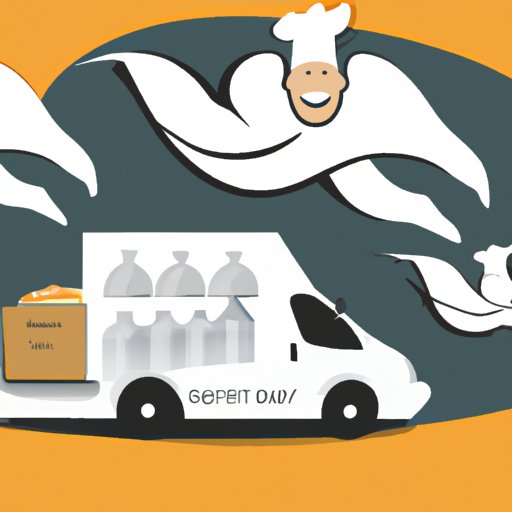Introduction
In recent years, the restaurant industry has experienced a dramatic shift in the way food is ordered and delivered. One of the most notable changes is the emergence of ghost kitchens—a concept that is quickly gaining traction among restaurants looking for new ways to increase their profits and expand their reach. But what exactly is a ghost kitchen? In this article, we’ll explore what a ghost kitchen is, how it works, and the benefits and challenges associated with operating one.

Exploring the World of Ghost Kitchens: What They Are and How They Work
A ghost kitchen, also known as a virtual kitchen or dark kitchen, is a commercial kitchen that is dedicated solely to preparing food for delivery or takeout orders. These kitchens are typically located in shared spaces such as warehouses, industrial parks, or existing restaurants. Unlike traditional restaurants, ghost kitchens do not have any physical dining space or storefronts; instead, they focus solely on producing food for delivery.
There are two main types of ghost kitchens: those that are operated by restaurant owners and those that are run by third-party companies. Restaurant-owned ghost kitchens are typically used to expand the reach of an existing restaurant, while third-party ghost kitchens are typically used by multiple restaurants to produce food for delivery.
The benefits of operating a ghost kitchen are numerous. For starters, ghost kitchens require less overhead than traditional restaurants, as they do not need to invest in physical space or staff. Additionally, ghost kitchens can help restaurants increase their profits by reaching new customers, eliminating wait times, and reducing food waste. Finally, ghost kitchens allow restaurants to experiment with new menus and dishes without having to invest in additional dining space.
A Guide to Starting Your Own Ghost Kitchen
If you’re interested in starting your own ghost kitchen, there are a few key steps you’ll need to follow. First, you’ll need to research different ghost kitchen options to determine which one best meets your needs. You’ll then need to find the right location for your kitchen, as well as secure the necessary equipment and supplies. Once you’ve established your kitchen, you’ll need to develop a menu that meets the needs of your customers.
When it comes to finding the right location for your ghost kitchen, you’ll want to consider factors such as accessibility, size, and cost. For example, if you plan to operate a third-party ghost kitchen, you may want to consider a larger space that can accommodate multiple restaurants. Alternatively, if you plan to open a restaurant-owned ghost kitchen, you may want to consider a smaller space that is closer to your existing restaurant.
Once you’ve secured the right location, you’ll need to establish your kitchen by setting up all of the necessary equipment, supplies, and storage areas. You’ll also need to hire staff to handle the day-to-day operations of the kitchen. Depending on the type of ghost kitchen you’re operating, you may need to hire specialized staff such as delivery drivers, chefs, and kitchen managers.
The Benefits of Opening a Ghost Kitchen
Opening a ghost kitchen can offer several benefits to restaurant owners. For starters, ghost kitchens can help increase profitability by reaching new customers and eliminating wait times. Additionally, ghost kitchens require less overhead than traditional restaurants, as they do not need to invest in physical space or staff. Finally, ghost kitchens offer greater flexibility, as they can be used to test out new dishes and menus without having to invest in additional dining space.

The Future of Food Delivery: Ghost Kitchens
As more people turn to delivery services for their meals, the demand for ghost kitchens is expected to continue to rise. This is due to the fact that ghost kitchens require less overhead and can produce food faster and more efficiently than traditional restaurants. Additionally, ghost kitchens are becoming increasingly popular with restaurant owners looking to reach new customers and expand their reach.
The growing popularity of delivery services has had a significant impact on the restaurant industry. As more people turn to delivery services for their meals, many traditional restaurants are struggling to keep up with the demand. This is where ghost kitchens come in; by providing a cost-effective solution to increasing demand, ghost kitchens are helping to level the playing field for restaurant owners.

The Pros and Cons of Operating a Ghost Kitchen
As with any business venture, there are both pros and cons to operating a ghost kitchen. On the plus side, ghost kitchens can offer increased revenue potential, lower operational costs, and greater flexibility. On the other hand, ghost kitchens can limit customer interaction, require specialized staff, and can be difficult to manage when operating multiple locations.
Conclusion
In conclusion, ghost kitchens are an increasingly popular trend in the restaurant industry. By offering increased profits, reduced overhead costs, and greater flexibility, ghost kitchens offer a cost-effective solution for restaurants looking to expand their reach and increase their profits. While there are some challenges associated with operating a ghost kitchen, these can be managed with careful planning and preparation. Ultimately, ghost kitchens are a great option for restaurants looking to increase their reach and boost their bottom line.


